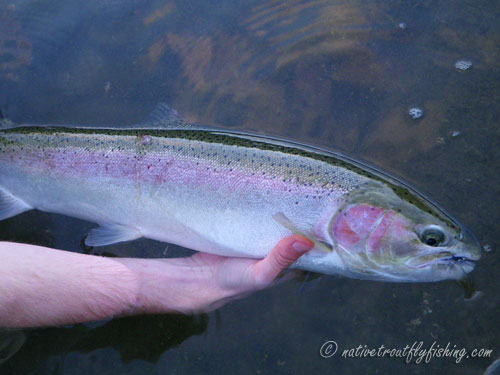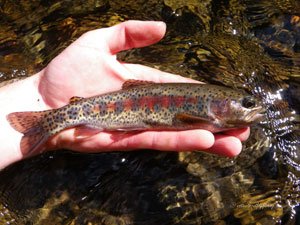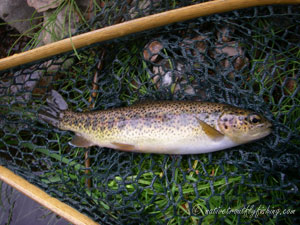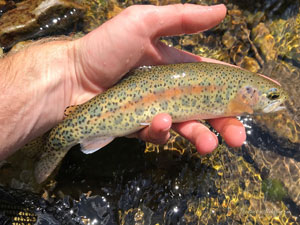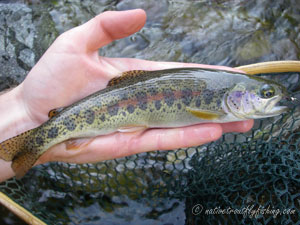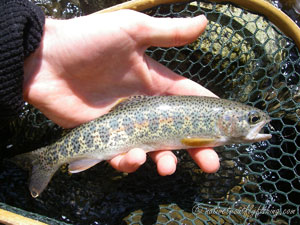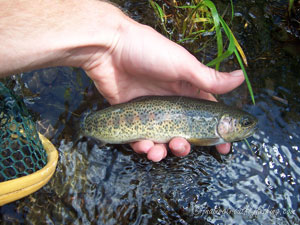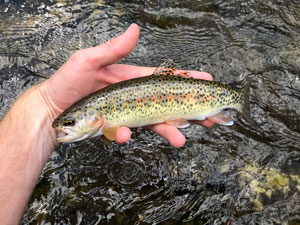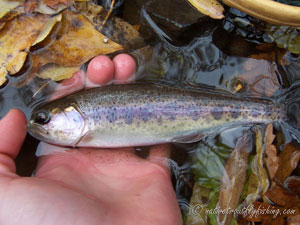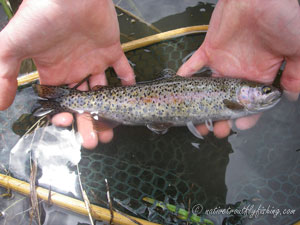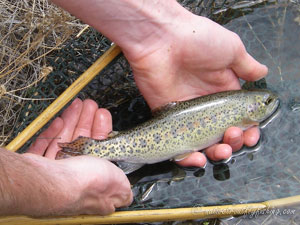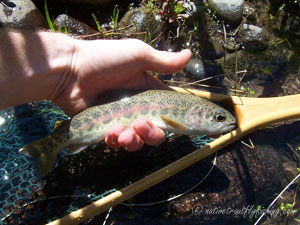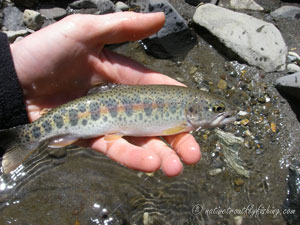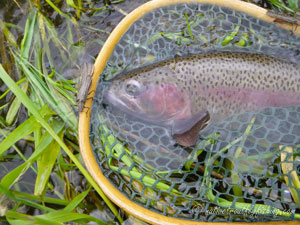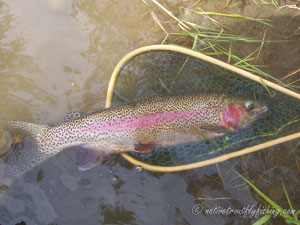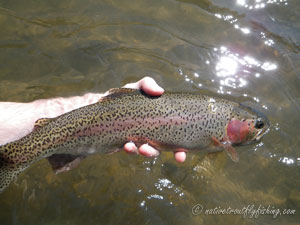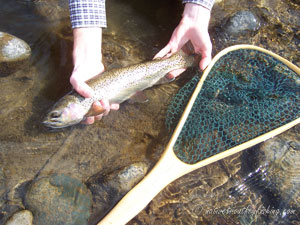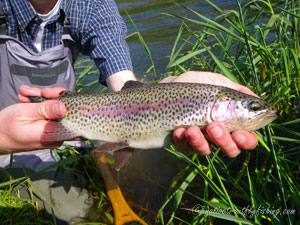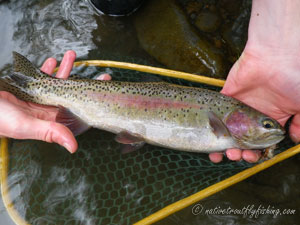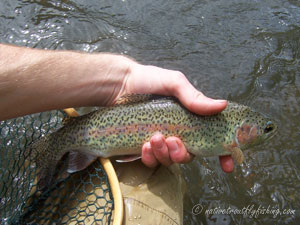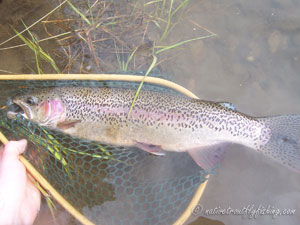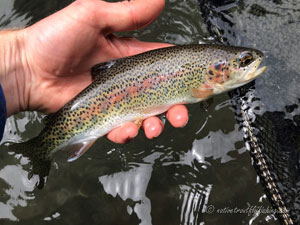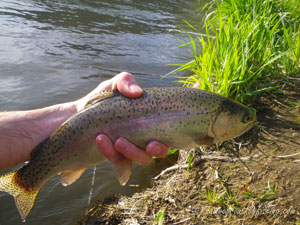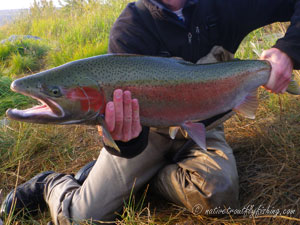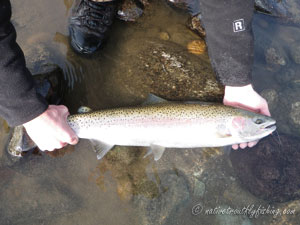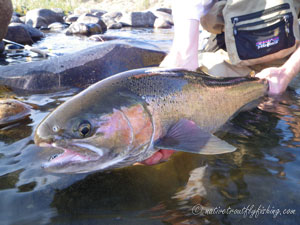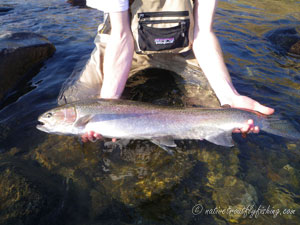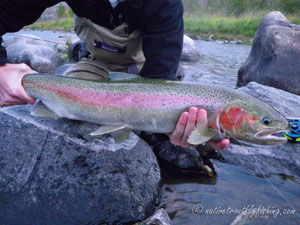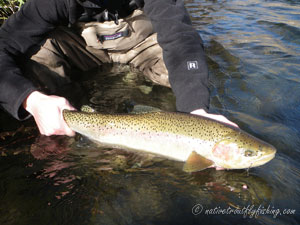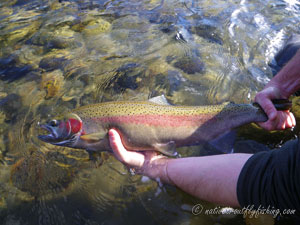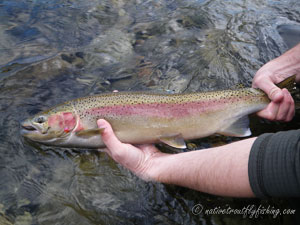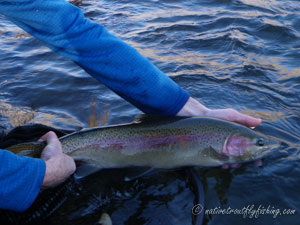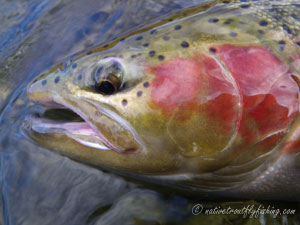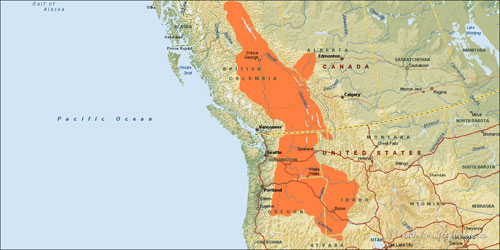Columbia Basin Redband
Oncorhynchus mykiss gairdneri
A wild Columbia Basin Redband Steelhead from Eastern Washington
Introduction
Columbia Basin Redband Trout are native to the Columbia River Basin east of the crest of the Cascade Mountains up to Shoshone Falls on the Snake River and the Fraser River drainage upstream of Hells Gate in British Columbia. Just to the east of the Cascade Crest, the Klickitat River appears to be a zone of contact between the Coastal Rainbow Trout and Columbia Basin Redband, with Klickitat fish representing an intermediate between these two lineages (Blakenship et al. 2011) and a similar zone of contact appears to exist on the Fraser River. Other genetic results have indicated that the boundary line may not be as clear cut and suggest more mixing between interior Redband and Coastal Rainbow Trout populations (McCusker et al. 2000). Columbia Basin Redband Trout were first described as Salmo gairdneri in 1836, from Steelhead collected in the Columbia River (Richardson 1836). Historically, several forms of Columbia Basin Redband Trout were recognized as distinct subspecies, the Kamloops Trout Oncorhynchus mykiss kamloops and the Mountain Kamloops Trout Oncorhynchus mykiss whitehousi (Jordan 1892, Dymond 1931). Both of these forms of trout are now just recognized as components of the Columbia Basin Redband Trout subspecies. Another unique Redband Trout, the Athabascan Rainbow Trout is found in the Athabasca River and its tributaries, east of the Continental Divide in Alberta Canada. Recent genetic studies indicate that it is closely related to Redband populations in the upper Fraser River and likely originated from headwater transfer at the end of the last ice age and it is not considered a distinct subspecies (Rasmussen and Taylor 2009). There are four isolated forms of ancestral Redband Trout that genetics and taxonomic characteristics indicate are related to Columbia Basin Redband Trout with the Harney-Mahleur Basin Redband, and Catlow Valley considered forms of Columbia Basin Redband Trout, while are White River Redband, Fort Rock Redband unique enough to warrant subspecies status, ,(Behnke 2002, Currens et al. 2009, DeHann et al. 2015). Much of the native range of the Columbia Basin Redband overlaps with Westslope Cutthroat and these two species avoid hybridization by utilizing different habitat and spawn timing, with the Redbands typically concentrated in the lower to mid-reaches and the Cutthroat found in the upper reaches of streams (Trotter 2008).
Life History Information
The native range of the Columbia Basin Redband Trout covers a vast area and these trout exhibit stream resident, fluvial, adfluvial and anadromous (Redband Steelhead) life history strategies to take full advantage of the available habitats. Like all native Rainbow Trout, Columbia Basin Redbands spawn during the spring, with most of the spawning activity in the Columbia Basin taking place between April and June.
Stream Resident and Fluvial Form
Stream resident Columbia Basin Redbands generally have an average size of between 6” to 10” (15 to 25 cm), while fluvial Redbands may exceed 20” (50cm). Columbia Basin Redbands as well as Great Basin Redbands found in the arid portions of their range have a higher tolerance to high temperatures in comparison to other salmonids (Behnke 1992). Zoellick (1999) showed that Columbia Basin Redbands native to the Owyhee River drainage in Idaho can survive in temperatures up to 84.2°F (29°C). This tolerance to high temperatures has allowed these fish to survive in harsh desert environments that would be in hospitable to most other trout. Redband Trout fry typically utilize stream margins, backwaters or shallow areas, whereas trout age-1 or older use areas greater than 1.5’ deep (0.5 m) with rocky substrate and woody debris (Hirsch 1995). The preferred habitat for stream resident Redbands is generally low gradient, medium elevation stream reaches with an abundance of complex pools (Muhlfeld et al. 2001). These stream resident Redband Trout are primarily drift feeders, preying on aquatic and terrestrial invertebrates. Fluvial Redband also rely heavily on aquatic and terrestrial invertebrates but become piscivorous as they get larger. Where they overlap with Pacific Salmon, Columbia Basin Redbands will also feed on eggs behind spawning salmon, flesh from dead salmon and juvenile salmon. Most fluvial Redbands have relatively small home ranges and do not typically make extensive spawning migration. Hockersmith et al. (1995) Showed that Redbands in the upper Yakima River are primarily mainstem spawners, with most migrations to the spawning being less than 9 miles (15 km). Stream dwelling Redband Trout typically spawn for the first time at age-2 to age-4 with males maturing 1-2 years prior to females (Schill et al. 2010). Redbands in the Yakima River spawn between the end of March and early-May, when water temperatures are between 45°F to 51°F (7.2°C and 10.6°C) (Hockersmith et al. 1995). Whereas stream resident Redband Trout in the Kootenai River drainage in Montana spawn in early-June, shortly after spring runoff subsided and water temperatures reach 45°F (7°C) (Muhlfeld 2002). Spawning occurs primarily in the tailouts of pools, although they also utilize riffles and runs with suitable depth and substrate size.
Adfluvial Form
Adfluvial populations of Columbia Basin Redband Trout are common in the large lakes of the upper Columbia and Fraser Rivers in Canada and are commonly referred to as Kamloops Trout. The Gerrard strain of these fish, which is native to Kootenay Lake have a genetic predisposition for reaching large sizes with fish as larger 52 pounds being recorded (Behnke 2002). In Shuswap Lake, juvenile adfluvial Redbands typically rear in tributaries for 1 to 3 years prior to migrating downstream into the lake and quickly moving offshore to forage, only rarely utilizing nearshore habitat for foraging (Rosenau 2014). In adfluvial populations found in reservoirs upstream of dams that blocked anadromous access, juvenile Redbands appear to migrate downstream to the reservoirs at the same time and age as steelhead populations and show signs of smolting, suggesting that they may retain their potential for anadromy (Holeck et al. 2012). Upon entering lakes, juvenile adfluvial Redband Trout feed primarily on insects until they reach 10” (25 cm), after which they become increasingly piscivorous (Rosenau 2014). In Kootenay Lake, Gerrard strain Redbands primarily feed on terrestrial insects and Kokanee Salmon, with Kokanee more prominent in the diets of larger fish (Irvine 1978, Andrusak and Parkinson 1984). Kokanee and juvenile Sockeye Salmon have also been shown to be important prey items in other adfluvial populations in Arrow Lakes, Lake Okanagan, Quesnel Lake, and Shuswap Lake. Redbands in these lakes will aggregate off stream mouths to feed on drifting eggs during Sockeye/Kokanee spawning and prey on out-migrating fry during the spring (Rosenau 2014). Gerrard Redbands typically migrate upstream into the Lardeau River to spawn starting in April and generally take 11 days to reach their spawning grounds (Irvine 1978). These spawners are typically 5 to 6 years old, with an average size of 31” (80 cm) and a fecundity of approximately 8,000 eggs per female. After spawning fish migrate back downstream during May almost immediately after spawning.
Anadromous Form
While Coastal Steelhead have both winter and summer run types, Redband Steelhead only exhibit a summer-run type, with fish entering freshwater between May and September (Behnke 2002). Unlike most other anadromous salmonids summer run steelhead mature in freshwater, overwintering in rivers for 6-10 months prior to spawning in the spring (Keefer et al. 2008a). The exception to this is populations in the transition zone between Coastal and Redband Steelhead, where both winter and summer run types may be present. In the Columbia River drainage, there are two distinct summer run types, known as A-run and B-run. The A-run fish are composed of younger, smaller fish that enter the river during June through August and are primarily heading to Columbia River tributaries or the upper Snake River and Grand Ronde drainages (Copeland et al. 2017). The B-run fish are larger and enter the river between August and September and primarily come from the Clearwater and Salmon River watersheds (Chrisp and Bjornn 1978). The majority of B-run fish historically spawned in the North Fork Clearwater River, but that population was lost when Dworshak Dam was built without fish passage. Only 52% of A-run fish spend two-years in the ocean, while 82% of B-run fish spend two years in the ocean (Copeland et al. 2017). After entering freshwater, early entry fish will often dip into tributaries such as the Deschutes River, which serve as cold water refuges during summer when the water temperatures in the Columbia River exceed 70°F (21°C) (Hess et al. 2016). According to High et al. (2006), and average of 61% of Steelhead destined for the upper Columbia and Snake Rivers temporarily staged in one or more downstream tributaries. Once water temperatures begin to cool, fish resume their migration with 12.4% of fish overwintering in the mainstem Columbia or Snake Rivers, and the rest overwintering in tributaries (Keefer et al. 2008a), although late-arriving fish are much more likely to overwinter in the mainstem than early arriving fish (Fuchs et al. 2021). While Steelhead have a relatively strong homing behavior, it is common for them to overshoot their natal streams by as much as 75 miles (120 km) (Richins and Skalski 2018, Feeken et al. 2019). However, these fish do typically fall back downstream and return to their natal streams to spawn (Boggs et al. 2004). Starting in early January and peaking in March, Steelhead move into their spawning tributaries. Redband Steelhead generally spawn from late-March through May, during the spring run off period, when water temperatures reach 43°F (6°C) (Archibald 2004, Archibald 2009, Baldwin 2007). Redband Steelhead travel much further inland than Coastal Steelhead to reach their spawning grounds and while they are iteroparous, less than 1% of these fish typically survive to spawn a second time (Behnke 2002, Keefer et al. 2008b). Of Snake River fish that do survive to spawn a second time, the majority are female and 51.4% first spawn after one year in the ocean and 55.4% of repeat spawners skip a year between spawning events (Copeland et al. 2019).
While there is a genetic influence on life history, anadromous Redband parents may give rise to freshwater resident offspring or vice versa (Kendall et al. 2015). After hatching, juvenile Redband Steelhead have a similar life history to that of freshwater resident Redbands. Juvenile Steelhead typically feed mainly on aquatic and terrestrial insects, with terrestrial invertebrates making up between 10% and 58% of the diet of sub-yearling fish (Johnson 1985). However, as they get older juvenile Steelhead may also prey on fish such as sculpin or juvenile salmon. After their first fall, juvenile Steelhead will often migrate out of small stream tributaries into larger streams or main stem rivers to continue rearing (Tattam 2006), generally spending two to three years freshwater before migrating to the ocean at a size of 5.5” to 7” (14-18 cm) (Chrisp and Bjornn 1978). Females typically account for the majority of out-migrating smolts, suggesting that males have a higher likelihood of remaining in freshwater (Peven et al. 1994) and populations with older smolts are also more likely to return at an older age (Copeland et al. 2017). Prior to beginning to migrate downstream juvenile Steelhead take on a silvery color and downstream migration typically peaks in mid-April to mid-May during peak spring flows (Chrisp and Bjornn 1978). Upon entering marine waters, Steelhead move offshore quickly and by their first year, they tend to aggregate off the southern tip of the Aleutian Islands (McKinnell et al. 1997). While little is known about differences in the habits of Redband and Coastal Steelhead at sea, it is believed that they exhibit similar tendencies. As such, it is thought that the diet of Redband Steelhead at sea is comprised mostly of fish and squid (LeBrasseur 1966). After spending between 1.5 and 2.5 years travelling the ocean in search of food, the cycle continues with Steelhead returning to freshwater to spawn for the first time.
Status
Columbia Basin Redband Trout have suffered from the same issues that have plagued many other western trout and salmon. As with Pacific salmon, overfishing, habitat destruction, hydroelectric dams, and competition or hybridization with hatchery fish have all been causes of their decline. There are three genetically distinct populations of anadromous Redbands in the Columbia basin and four in the Fraser River drainage. In the Columbia Basin, the upper Columbia Basin Steelhead are listed as endangered (NMFS 1997), and the Snake River and Mid-Columbia Basin Redband Steelhead are listed as threatened under the ESA (NMFS 1997, NMFS 1999). In the Fraser River drainage, the Thompson and Chilcotin River Steelhead are listed as endangered, and the southern transition and south interior populations are currently not listed (COSEWIC 2018).
In the Columbia River drainage, the single greatest threat to Steelhead populations has been the construction of dams. More than 100 dams have been built in the Columbia River drainage for power generation, irrigation, water storage and navigation. The construction of Grand Coulee Dam alone, blocked access to over 1,100 miles of Redband Steelhead habitat. Dams on the Snake River in Hells Canyon also blocked fish passage and it is thought that Steelhead runs were reduced by over 50% in the Columbia Basin due to dams (Chrisp and Bjornn 1978). Beyond directly blocking access, dams that do have passage often have high mortality rates for juvenile Steelhead passing downstream. During the 1970’s the survival of Steelhead passing through each dam on the Snake River was typically around 77-80%, which had a major cumulative effect on the downstream survival of smolts from the upper basin that pass through four Snake River dams and an additional four dams on the Columbia River before reaching the ocean (Muir et al. 2001). Due to this, the operation of the hydrosystem has changed to allow increased flow during spring, which has improved survival rates for Steelhead smolts. Adult Steelhead typically have a much more challenging time moving downstream through dams in the Columbia Basin and this is a contributing factor to the extremely low repeat spawner rate for Redband Steelhead. Due to this kelt reconditioning programs have been adopted in some watersheds to improve repeat spawner survival. In the Yakima River, short-term kelt reconditioning and transportation below Bonneville Dam increased survival from 2.7% to 3.2%. In contrast a long-term reconditioning program, where fish were released back into the Yakima River after a year of reconditioning increased survival to 11.5% to 17.6% (Trammell et al. 2016). On top of passage issues, hatchery supplementation was chosen as one of the primary methods to mitigate for the impacts of dams on the Columbia and Snake Rivers. However, while hatcheries can be successful at providing fish for fisheries, their success in supplementing natural populations has been more mixed. Part of the issue is that hatchery fish often have a much lower reproductive success compared to wild populations, with fish that had to hatchery parents have a less than 20% the reproductive success of natural origin spawners (Ford et al. 2016). When these hatchery fish spawn with wild populations, it in maladapted offspring, which may behave differently and have a lower survival when compared to wild fish (Berntson et al. 2011). Beyond the construction of dams and hatcheries, perhaps the greatest current threat to Steelhead populations is poor ocean survival. For threatened Fraser River populations, such as the Thompson Rivers, where dams do not represent a major threat, poor ocean survival is through to the leading factor leading to declines in Steelhead returns (Levy and Parkinson 2014).
Adfluvial Redband Trout have also been impacted by both habitat destruction as well as the introduction of non-native species. The Gerrard strain of Columbia Basin Redband Trout historically spawned primarily in the Duncan River, however the construction of a dam on the river eliminated this spawning aggregation and now only a limited area of the Lardeau River provides suitable spawning habitat for these fish (Irvine 1978, Behnke 2002). To protect this sensitive spawning population, the Lardeau River is now closed to all fishing during the spawning migration. Due to their large size, the Gerrard stain of Redbands have been stocked in many other lakes throughout the upper Columbia and Fraser basins. In Arrow Lakes, genetic analysis indicated that 80% of samples collected from Redband Trout in 1986-1988 were native Arrow Lake trout. However, samples collected from 1995 to 2004 showed that 86% of the fish were of Kootenay Lake origin, indicating that significant introgression between Gerrard trout and Arrow Lakes Trout had occurred (Taylor and Tamkee 2005). In addition to hatchery trout, mysid shrimp were introduced to many of the large lakes of the upper Columbia and Fraser Basin to improve the Kokanee populations. However, these introductions had the opposite effect as mysid prey on the same food source as Kokanee (zooplankton) and are largely unavailable to Kokanee as a prey source due to how the utilize the lake habitat. Due to this there has been a sharp decline in Kokanee stocks, the primary prey source for larger Redband Trout in many of these lakes.
Stream resident and fluvial populations have also suffered declines over the last century. While stream dwelling, Redband trout abundance has been relatively stable in higher elevation areas, habitat impacts have been greater in lower elevation desert streams. In the low elevation arid streams of the Snake River basin, the proportion of juvenile Redband Trout declined from 48% to 25% from the 1970’s to the 1990’s, likely because of habitat degradation (Zoellick et al. 2005). Due to this in 1995, the Redband Trout of the desert basins of the Snake River in Idaho were petitioned to be listed under the endangered species list (USFWS 1995). While Snake River Redbands were not listed, they still remain a conservation concern. The biggest threat to non-anadromous Columbia Basin Redband Trout has been the introduction of non-native trout. In the Snake River Basin of Idaho alone, approximately 43 million hatchery Rainbow Trout were stocked into native Redband waters between 1913 and 2001 (Meyer et al. 2014). However, unlike with Cutthroat where hybridization with hatchery Rainbow Trout often leads to the replacement of native populations, effects for Columbia Basin Redband are often much more localized (Bohling et al. 2019) with Columbia Basin Redband populations retaining their overall genetic integrity. In the Upper Deschutes and Yakima Basins, where hatchery Rainbow Trout have been stocked extensively, introgression with hatchery fish is geographically limited to areas where hatchery fish had been actively planted (Campton and Johnston 1985, Blankenship et al. 2011, Bohling et al. 2017). However, in other cases, such as in the Boise River in Idaho, hybridization with hatchery Rainbow Trout has been more extensive. A study by Neville and Dunham (2011) showed that hybridization with hatchery Rainbow Trout had occurred at 40% of the sampled locations. Additionally, in a case of role reversal, several Redband populations also showed high levels of hybridization with introduced Cutthroat in some locations. Based on a study by Meyer et al. (2014), it was estimated that genetically pure populations of Redband Trout are still found in about 68% of their native streams in the upper Snake River Basin. These same issues have also impacted Redband populations in Canada and due to a combination of competition and hybridization with hatchery fish and habitat destruction, the Athabascan Rainbow Trout are currently considered Endangered (Rasmussen and Taylor 2009).
Despite advances in our understanding of Columbia Basin Redband Trout and ongoing conservation efforts, their future remains uncertain. Non-anadromous populations are unlikely to a go extinct in the near future, but habitat destruction and the hybridization and competition with non-native species will continue to threaten them across much of their range. The future of anadromous populations is considerably more precarious, especially given a warming climate and changing ocean conditions. 2021 marked the lowest return of Redband Steelhead to the Columbia Basin on record, resulting in the closure of recreational fisheries in many rivers and an uncertain future for these fish.
Description
Columbia Basin Redband trout got their name from the red band along their lateral line. These fish usually have large spots spread across their body and fins, although some populations a sparsely spotted, with their spots concentrated above their lateral line. Like other fish in the Rainbow Trout lineage, Columbia Basin Redbands have red to rosy colored gill plates. The coloration of these fish tends to be greenish olive on the back transitioning to a yellow or even an orange coloration on their lower half. Adfluvial and anadromous populations of Redbands display a silvery coloration while found in lake or oceanic environments. However, their silver coloration fades to the colors typical of fish found in a stream resident population as spawning approaches. These fish may display yellow- or orange-colored slashes under their lower jaw, which has historically led to taxonomic confusion with Cutthroat Trout.
Stream Resident Form
Click on images to view a larger picture
Fluvial Form
Native Range
A map of the native range of the Columbia Basin redband trout. Data Sources: Behnke (2002) and Augerot et al. (2005).
References
Archibald, P. 2004. 2003 spring spawning surveys for rainbow/ steelhead trout. United States Forest Service, Wenatchee, Washington.
Archibald, P. 2009. 2008 Mad River rainbow/ steelhead trout spawning surveys. United States Forest Service, Wenatchee, Washington.
Andrusak, H. and E.A. Parkinson. 1984. Food habits of Gerrard stock rainbow trout in Kootenay Lake, British Columbia. Ministry of Environment, Fish and Wildlife Branch, Nelson British Columbia, Canada. Fisheries Technical Circular No. 60.
Baldwin, C.M. 2007. Steelhead spawning ground surveys, temperature, and discharge monitoring in small tributaries of the Columbia River upper middle mainstem subbasin, 2005-2007. Washington Department of Fish and Wildlife. Olympia, Washington.
Berntson, E.A., R.W. Carmicheal, M.W. Flesher, E.J. Ward and P. Moran. 2011. Diminished reproductive success of steelhead from a hatchery supplementation program (Little Sheep Creek, Imnaha Basin, Oregon). Transactions of the American Fisheries Society 140(3): 685-698.
Blankenship, S.M, M.R. Campbell, J.E. Hess, M.A. Hess, T.W. Kassler, C.C. Kozfkay A.P. Matala, S.R. Narum, M.M. Paquin, M.P. Small, J.J. Stephenson, K.I. Warheit and P. Moran. 2011. Major lineages and metapopulations in Columbia River Oncorhynchus mykiss are structured by dynamic landscape features and environments. Transactions of the American Fisheries Society 140: 665-684.
Behnke, R. J. 1992. Native trout of western North America. American Fisheries Society Monograph 6. American Fisheries Society, Bethesda, Maryland.
Behnke, R. 2002. Trout and Salmon of North America. Chanticleer Press, New York.
Boggs, C.T., M.L. Keefer, C.A. Peery and T.C. Bjornn. 2004. Fallback, reascension, and adjusted fishway escapement estimates for adults Chinook Salmon and Steelhead at Columbia and Snake River dams. Transactions of the American Fisheries Society 133: 932–949.
Bohling, J., J. Von Bargen and S. Starcevich. 2017. Evaluation of genetic population structure and effective population size among populations of redband trout in the Deschutes River Basin, OR. Abernathy Fish Technology Center, United States Fish and Wildlife Service, Longview, Washington.
Copeland, T., M.W. Ackerman, K.K. Wright and A. Byrne. 2017. Life history diversity of Snake River Steelhead populations between and within management categories. North American Journal of Fisheries Management 37: 395–404.
Copeland, T., B.J. Bowersox, M.W. Ackerman and C. Camacho. 2019. Patterns of iteroparity in wild Snake River Steelhead. Transactions of the American Fisheries Society 148: 926–937.
COSEWIC. 2018.Techinical summaries and supporting information for emergency assessments Steelhead Trout Oncorhynchus mykiss (Thompson River and Chilcotin River populations). Committee on the Status of Endangered Wildlife in Canada. Ottawa.
Chrisp, E.Y. and T.C. Bjornn. 1978. Parr-smolt transformation and seaward migration of wild and hatchery steelhead trout in Idaho. Idaho Department of Fish and Game, Boise, ID.
DeHaan, P., J. Von Bargen, M. Meeuwig and S. Clements. 2015. Great Basin redband trout genetic status assessment. United States Fish and Wildlife Service. Longview, Washington.
Dymond, JR. 1931. Description of two new forms of British Columbia Trout. Contributions to Canadian Biology and Fisheries 6(1): 391-395.
Feeken, S.F., B.J. Bowersox, M.E. Dobos, M.P. Corsi, M.C. Quist and T. Copeland. 2019. Distribution and movement of steelhead and anglers in the Clearwater River, Idaho. North American Journal of Fisheries Management 39(5): 1056-1072.
Ford, M.J, A.R. Murdoch, M.S. Hughes, T.R. Seamons and E.S. LaHood. 2016. Broodstock history strongly influences natural spawning success in hatchery steelhead (Oncorhynchus mykiss). PLoS ONE 11(10): e0164801. doi:10.1371/journal.pone.0164801
Fuchs, N.T. C.C. Caudill, A.R. Murdoch and B.L. Truscott. 2021. Overwintering distribution and postspawn survival of steelhead in the upper Columbia River basin. North American Journal of Fisheries Management 41(3): 757-774. DOI: 10.1002/nafm.10585
Hess, M.A., J.E. Hess, A.P. Matala, R.A. French, C.A. Steele, J.C. Lovtang and S.R. Narum. 2016. Migrating adult steelhead utilize a thermal refuge during summer periods with high water temperatures. ICES Journal of Marine Science 73(10): 2616–2624. doi:10.1093/icesjms/fsw120
High, B., C.A. Peery and D.H. Bennett. 2006. Temporary staging of Columbia River summer steelhead in coolwater areas and its effects on migration rates. Transactions of the American Fisheries Society 135: 519-528.
Hirsch, C.L. 1995. Seasonal shifts in Redband Trout use of pools and their microhabitats in three central Oregon streams. Masters Thesis. Oregon State University, Corvalis, Oregon.
Hockersmith, E., J. Vella and L. Stuehrenberg. 1995. Yakima River radio-telemetry study: rainbow trout, 1993. Bonneville Power Administration, Portland, Oregon and NOAA Fisheries, Seattle Washington. Project 89-089.
Holecek, D.E., D.L. Scarnecchia and S.E. Miller. 2012. Smoltification in an impounded, adfluvial redband trout population upstream from an impassable dam: does it persist? Transactions of the American Fisheries Society, 141(1): 68-75.
Irvine, J. R. 1978. The Gerrard rainbow trout of Kootenay Lake, British Columbia; a discussion of their life history with management, research and enhancement recommendations. British Columbia Fish and Wildlife Branch. Fisheries Management Report, No. 72.
Johnson, J.H. 1985. Comparative diets of Paiute sculpin, speckled dace, and subyearling steelhead trout in tributaries of the Clearwater River, Idaho. Northwest Science 59(1): 1-9.
Jordan, D. S. 1892. Description of a new species of salmon, Oncorhynchus kamloops, from the lakes of British Columbia. Forest and Stream 39:405-406.
Keefer, M.L., C.T. Boggs, C.A. Peery and C.C. Caudill. 2008a. Overwinter distribution, behavior, and survival of adult summer Steelhead: variability among Columbia River populations. North American Journal of Fisheries Management 28:81–96.
Keefer, M.L., R.H. Wertheimer, A.F. Evans, C.T. Boggs, and C.A. Perry. 2008b. Iteroparity in Columbia River summer-run steelhead (Oncorhynchus mykiss): implications for conservation. Canadian Journal of Fisheries and Aquatic Sciences 65: 2592–2605.
LeBrasseur, R.J. 1966. Stomach contents of salmon and steelhead trout in the northeastern Pacific Ocean. Journal of the Fisheries Research Board of Canada 23: 85-100.
Levy, D.A. and E. Parkinson. 2014. Independent review of the science and management of Thompson River steelhead. Prepared for Thompson Steelhead Technical Subcommittee c/o Cook's Ferry Indian Band, Spences Bridge, BC. 104p.
McCusker, M.R., E. Parkinson and E.B. Taylor. 2000. Mitochondrial DNA variation in Rainbow Trout (Oncorhynchus mykiss) across its native rane: testing biogeographical hypotheses and their relevance to conservation. Molecular Ecology 9: 2089-2108.
McKinnell, S., J.J. Pella and M.L. Dahlberg. 1997. Population-specific aggregations of steelhead trout (Oncorhynchus mykiss) in the North Pacific Ocean. Canadian Journal of Fisheries and Aquatic Sciences 54: 2368–2376.
Muir, W.D., S.G. Smith, J.G. Williams, E.E. Hockersmith and J.R. Skalski. 2001. Survival estimates for migrant yearling Chinook salmon and steelhead tagged with passive integrated transponders in the lower Snake and lower Columbia Rivers, 1993-1998. North American Journal of Fisheries Management 21: 269–282.
Mulhfeld, C.C., Bennett, D.H., and Marotz, B. 2001. Summer Habitat Use by Columbia River Redband Trout in the Kootenai River Drainage, Montana. North American Journal of Fisheries Management 21: 223-235.
Muhlfeld, C.C. 2002. Spawning characteristics of Redband Trout in a headwater stream in Montana. North American Journal of Fisheries Management 23: 1314-1320.
Meyer, K.A., D.J. Schill, E.R.J.M. Mamer, C.C. Kozfkay and M.R. Campbell. 2014. Status of Redband Trout of the upper Snake River basin of Idaho. North American Journal of Fisheries Management 34: 507-523.
Neville, H.M. and J.B. Dunham. 2011. Patterns of hybridization of nonnative Cutthroat Trout and hatchery Rainbow Trout with native Redband Trout in the Boise River, Idaho. North American Journal of Fisheries Management 31: 1163-1176.
NMFS (National Marine Fisheries Service). 1997. Endangered and threatened species: listing of several evolutionary significant units (ESUs) of West Coast Steelhead. Federal Register 62:43937. August 18, 1997.
NMFS (National Marine Fisheries Service). 1999. Endangered and threatened species: threatened status for two ESUs of Steelhead in Washington and Oregon. Federal Register 64:14517. March 25, 1999.
Peven, C.M., R.R. Whitney and K.R. Williams. 1994. Age and length of steelhead smolts from the Mid-Columbia River Basin, Washington. North American Journal of Fisheries Management 14:77-86.
Rasmussen, J.B. and E.B. Taylor. 2009. Status of the Athabasca Rainbow Trout (Oncorhynchus mykiss) in Alberta. Alberta Wildlife Status Report No. 66. Alberta Conservation Association. Edmonton, AB, Canada.
Richardson, J. 1836. The fish. In: Fauna boreali-Americana; or the zoology of the northern parts of British America: containing descriptions of the objects of natural history collected on the late northern land expeditions, under the command of Sir John Franklin, R.N. J. Bentley, London. Part 3: i-xv + 1-327, Pls. 74-97.
Richins, S.M. and J.R. Skalski. 2018. Steelhead overshoot and fallback rates in the Columbia-Snake River basin and the influence of hatchery and hydrosystem operations. North American Journal of Fisheries Management 38(5): 1122-1137.
Rosenau, M.L. 2014. Review of draft manuscript report - nearshore habitat utilization by spawning char and rearing Rainbow Trout in Shuswap, Little Shuswap and Mara Lakes. Shuswap watershed owners association. Prepared by: Triton Environmental Consultants Ltd.
Schill, D.J., G.W. LaBar, E.R.J.M. Mamer and K.A. Meyer. 2010. Sex ratio, fecundity, and models predicting length at sexual maturity of redband trout in Idaho desert streams. North American Journal of Fisheries Management 30(5): 1352-1363.
Tattam, I.A. 2006. Seasonal life history of Oncorhynchus mykiss in the South Fork John Day River Basin, Oregon. Masters Thesis. Oregon State University, Corvalis, Oregon.
Taylor, E.B. and P. Tamkee. 2005. Microsatellite DNA polymorphism in rainbow trout (Oncorhynchus mykiss) from the Arrow Lakes, British Columbia. Part III: Analysis of historical samples to assess introgression between introduced Kootenay Lake trout and native Arrow Lakes trout. Final Report to: The Columbia Basin Fish and Wildlife Compensation Program, Nelson, BC.
Trammell, J.L.J. D.E. Fast, D.R. Hatch, W.J. Bosch, R. Branstetter, A.L. Pierce, J.W. Blogett and C.R. Frederiksen. 2016. Evaluating steelhead kelt treatments to increase iteroparous spawners in the Yakima River basin. North American Journal of Fisheries Management 36: 876–887.
Trotter, P. 2008. Cutthroat: Native Trout of the West. Second Edition. University of California Press, Berkley, CA.
USFWS (United States Fish and Wildlife Service). 1995. Endangered and threatened wildlife and plants; 90-day finding for a petition to list desert Redband Trout in the Snake River drainage above Brownlee Dam and below Shoshone Falls as threatened or endangered. Federal Register 60(187):49819-49821. September 5, 2012.
Zoellick, B. W. 1999. Stream temperatures and the elevational distribution of redband trout in southwestern Idaho. Great Basin Naturalist 59(2):136-143.
Contact
Feel free to contact me if you have any questions or comments
Columbia Basin Redband Trout Links
My Columbia Basin Redband Trips
Washington Department of Fish and Wildlife - Redband Trout
Oregon Department of Fish and Wildlife - Redband Trout
Idaho Department of Fish and Game - Redband Trout
Western Native Trout Initiative - Redband Trout
Native Trout Links
Truchas Mexicanas' - Native Trout of Mexico
Balkan Trout Restoration Group
Trout and Seasons of the Mountain Village - About Japanese Trout
Western Native Trout Challenge
California Heritage Trout Challenge
Fly Fishing Blogs
Dave B's Blog: Fly Fishing for Native Trout
The Search for Native Salmonids
Conservation Links
Western Native Trout Initiative
Fly Fishing Links
Fishing Art Links
Americanfishes.com - Joseph R. Tomelleri
